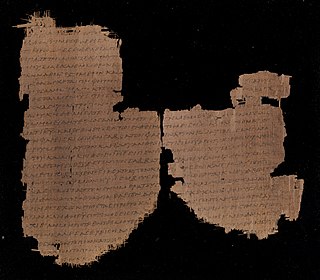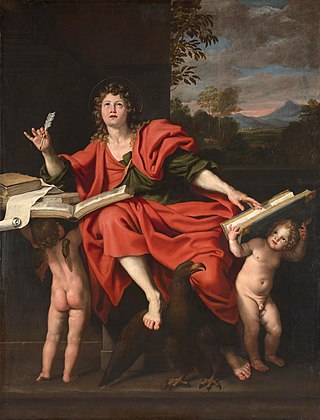
The Gospel of Luke tells of the origins, birth, ministry, death, resurrection, and ascension of Jesus Christ. Together with the Acts of the Apostles, it makes up a two-volume work which scholars call Luke–Acts, accounting for 27.5% of the New Testament. The combined work divides the history of first-century Christianity into three stages, with the gospel making up the first two of these – the life of Jesus the Messiah from his birth to the beginning of his mission in the meeting with John the Baptist, followed by his ministry with events such as the Sermon on the Plain and its Beatitudes, and his Passion, death, and resurrection.
Gospel originally meant the Christian message, but in the 2nd century it came to be used also for the books in which the message was reported. In this sense a gospel can be defined as a loose-knit, episodic narrative of the words and deeds of Jesus, culminating in his trial and death and concluding with various reports of his post-resurrection appearances. Modern biblical scholars are cautious of relying on the gospels uncritically, but nevertheless, they provide a good idea of the public career of Jesus, and critical study can attempt to distinguish the original ideas of Jesus from those of the later Christian authors.
The New Testament (NT) is the second division of the Christian biblical canon. It discusses the teachings and person of Jesus, as well as events in first-century Christianity. The New Testament's background, the first division of the Christian Bible, is called the Old Testament, which is based primarily upon the Hebrew Bible; together they are regarded as sacred scripture by Christians.

Paul, commonly known as Paul the Apostle and Saint Paul, was a Christian apostle who spread the teachings of Jesus in the first-century world. Generally regarded as one of the most important figures of the Apostolic Age, he founded several Christian communities in Asia Minor and Europe from the mid-40s to the mid-50s AD.
Frank Stagg was a Southern Baptist theologian, seminary professor, author, and pastor over a 50-year ministry career. He taught New Testament interpretation and Greek at New Orleans Baptist Theological Seminary from 1945 until 1964 and at the Southern Baptist Theological Seminary in Louisville, Kentucky from 1964 until 1978. His publications, recognitions and honors earned him distinction as one of the eminent theologians of the past century. Other eminent theologians have honored him as a "Teaching Prophet."
No one...has ever taken the New Testament more seriously than Frank Stagg, who spent his entire life wrestling with it, paying the price in sweat and hours in an unrelenting quest to hear the message expressed in a language no longer spoken and directed toward a cultural context so foreign to the modern reader.

In Christianity, Jesus is the Son of God as written in the Bible's New Testament, and in mainstream Christian denominations he is God the Son, the second Person in the Trinity. Christians believe him to be the Jewish messiah prophesied in the Hebrew Bible. Through Jesus's crucifixion and alleged resurrection, God reputedly offers humans salvation and eternal life, with Jesus's death interpreted as atoning for all sin, thus making humanity right with God.

The authorship of the Johannine works has been debated by biblical scholars since at least the 2nd century AD. The debate focuses mainly on the identity of the author(s), as well as the date and location of authorship of these writings.

Jesus, also referred to as Jesus Christ or Jesus of Nazareth, was a first-century Jewish preacher and religious leader. He is the central figure of Christianity, the world's largest religion. Most Christians believe he is the incarnation of God the Son and the awaited Messiah prophesied in the Hebrew Bible.

Walter Rauschenbusch (1861–1918) was an American theologian and Baptist pastor who taught at the Rochester Theological Seminary. Rauschenbusch was a key figure in the Social Gospel and single tax movements that flourished in the United States during the late 19th and early 20th centuries. He was also the maternal grandfather of the influential philosopher Richard Rorty and the great-grandfather of Paul Raushenbush.

Andronicus of Pannonia was a 1st-century Christian mentioned by the Apostle Paul in his Epistle to the Romans :
Salute Andronicus and Junia, my kinsmen, and my fellow prisoners, who are of note among the apostles, who also were in Christ before me.

Christian egalitarianism, also known as biblical equality, is egalitarianism based in Christianity. Christian egalitarians believe that the Bible mandates gender equality and equal responsibilities for the family unit and the ability for women to exercise spiritual authority as clergy. In contrast to Christian complementarianists and Christian patriarchists, proponents of Christian egalitarianism argue that Bible verses often used to justify patriarchal domination in gender roles are misinterpreted. Egalitarians believe in a form of mutual submission in which all people submit to each other in relationships and institutions as a code of conduct without a need for hierarchical authority.

The roles of women in Christianity have varied since its founding. Women have played important roles in Christianity especially in marriage and in formal ministry positions within certain Christian denominations, and parachurch organizations. In 2016, it has been estimated that the female share of the World's Christian Population is between 52 and 53 percent. The Pew Research Center studied the effects of gender on religiosity throughout the world, finding that Christian women in 53 countries are generally more religious than Christian men. While Christians of both genders in African countries are equally likely to regularly attend services. In 2020, it has been estimated that the female share of the World's Christian Population is around 51.6%.
Evelyn Stagg was a trailblazer for Southern Baptist women in ministry. She was an authority on classical studies, which led to her extensive research on the cultural/historical status and treatment of women in the ancient world, and in the world into which Jesus was born. Married to eminent Baptist theologian Dr. Frank Stagg for 66 years, she was a native of Ruston, Louisiana.
This is a glossary of terms used in Christianity.

The following outline is provided as an overview of and topical guide to Christianity:
The historical reliability of the Gospels is evaluated by experts who have not found a complete consensus. While all four canonical gospels contain some sayings and events which may meet one or more of the five criteria for historical reliability used in biblical studies, the assessment and evaluation of these elements is a matter of ongoing debate. Virtually all scholars of antiquity agree that a human Jesus existed, but scholars differ on the historicity of specific episodes described in the biblical accounts of Jesus, and the only two events subject to "almost universal assent" are that Jesus was baptized by John the Baptist and was crucified by the order of the Roman Prefect Pontius Pilate. Elements whose historical authenticity is disputed include the two accounts of the Nativity of Jesus, the miraculous events including the resurrection, and certain details about the crucifixion.

The relationship between Paul the Apostle and women is an important element in the theological debate about Christianity and women because Paul was the first writer to give ecclesiastical directives about the role of women in the Church. However, there are arguments that some of these writings are post-Pauline interpolations.

Jesus' interactions with women are an important element in the theological debate about Christianity and women. Women are prominent in the story of Jesus. He was born of a woman, had numerous interactions with women, and was seen first by women after his resurrection. He commissioned the women to go and tell his disciples that he has risen, which is the essential message of Christianity.
Historiography of early Christianity is the study of historical writings about early Christianity, which is the period before the First Council of Nicaea in 325. Historians have used a variety of sources and methods in exploring and describing Christianity during this time.

The New Testament Household Codes, also known as New Testament Domestic Codes, consist of instructions in New Testament writings associated with the apostles Paul and Peter to pairs of Christian people within the structure of a typical Roman household. The main foci of the Household Codes are upon husband/wife, parent (father)/child, and master/slave relationships. The Codes apparently were developed to urge the new first century Christians to comply with the non-negotiable requirements of Roman Patria Potestas law, and to meet the needs for order within the fledgling churches. The two main texts that address these relationships and duties are Ephesians 5:22–6:9 and Colossians 3:18–4:1. An underlying Household Code is also reflected in 1 Timothy 2:1ff., 8ff.; 3:1ff., 8ff.; 5:17ff.; 6:1f.; Titus 2:1–10 and 1 Peter 2:13–3:7. Historically, proof texts from the New Testament Household Codes—from the first century to the present day—have been used to define a married Christian woman's role in relation to her husband, and to disqualify women from primary ministry positions in Christian churches.